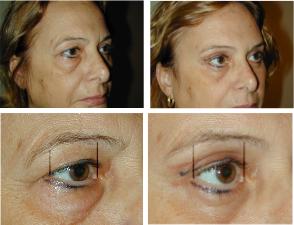Sunday, October 10, 2004
6168
An Alternative Approach to Browlift Fixation. Temporoparietalis Fascia, Galeal and Periostal Imbrication
Objectives and Purpose: Brow elevation is one of the goals of surgical rejuvenating procedures. An extended dissection of the frontotemporal flap, the release of links between galea-periosteum and the orbital rim, and changes in the functional balance between the frontal and depressor muscles by means of myotomies or myectomies are the required steps to attain this goal. These maneuvers may be done through an open, endoscopic or combined surgical approach. However the flap fixation method is a key factor to achieve a lasting result. We evaluate the results of a temporal suspension-fixation technique by means of TPF-galeal -periostal flaps imbrication through an open or endoscopically assisted approach. Methods and materials: Between October 1997 – October 2002, a total of 32 female patients ages between 44 and 72 years were operated under local anesthesia and sedation. The follow-up was 8 to 24 months, average of 15 months. In 23 cases, the frontotemporal lift was associated with a cervicofacial lift through separate incisions, in 19 with an upper-lower blepharoplasty done at the same time or subsequently. The open approach was used in 26 and a combined approach with endoscopic assistance and reduced temporal incisions was done in 6 cases. Technique: bitemporal 3-4cm incisions were placed 2 cm behind and parallel to the hairline. Once divided and dissected off the scalp the lateral TPF and the medial galea-periosteum, the frontotemporal flap was dissected through a combined subperiostal and sub TPF plane, dividing the fusion line, releasing and dividing the orbital rim periosteum lateral to the supraorbital notch and the orbital ligament. A superior orbicularis myotomy was done at the same time. Once obtained a free of tension flap, suspension - fixation was done by means of TPF- Galeal- Periostal flaps imbrication, advanced according the desired elevation and fixed to the deep temporal fascia with irresorbable mattress sutures. Very conservative resections of scalp rolls were done, based on the anterior flap. Results: Pre and postoperative measures were taken between the lower hairline of the eyebrow and the medial and lateral canthal angles. Lateral brow elevation ranged from 3 to 7mm, average 5mm. A lasting result was observed during the follow-up period, with partial relapse in 5 cases. Complications consisted of 2 transient frontal paresias, remarkable periorbital bruising in 4 cases, transient decrease in temporal hair density in 6 (6 to 8 months). No permanent alopecia was observed. Conclusions: Brow elevation is an essential feature for a pleasing esthetic result in the periorbital region. The best results are those in association with a blepharoplasty. We consider this suspension –fixation technique as predictable, low cost because does not need the use of hardware devices and feasible when an endoscope is not readily available. The results are lasting, and the incidence of sequelae and complications acceptable.
View Synopsis (.doc format, 464.0 kb)

